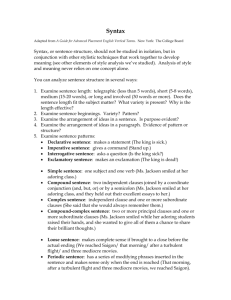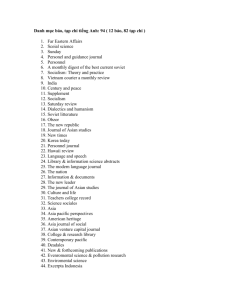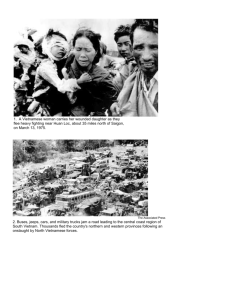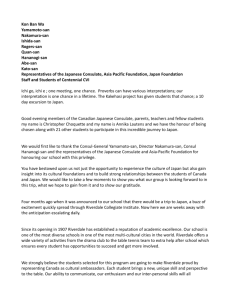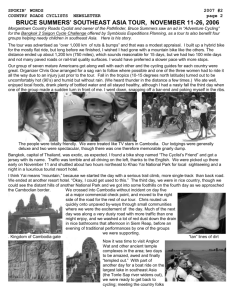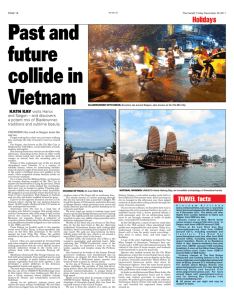Excerpts from History of the U.S. Consulate in Saigon
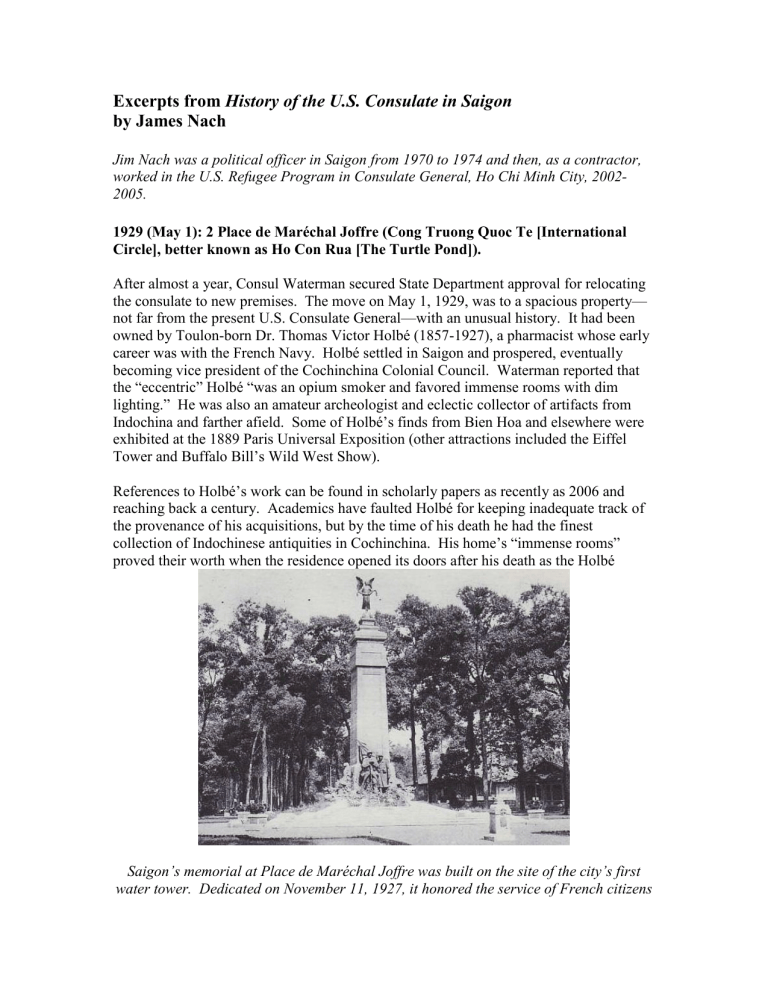
Excerpts from History of the U.S. Consulate in Saigon by James Nach
Jim Nach was a political officer in Saigon from 1970 to 1974 and then, as a contractor, worked in the U.S. Refugee Program in Consulate General, Ho Chi Minh City, 2002-
2005.
1929 (May 1): 2 Place de Maréchal Joffre (Cong Truong Quoc Te [International
Circle], better known as Ho Con Rua [The Turtle Pond]).
After almost a year, Consul Waterman secured State Department approval for relocating the consulate to new premises. The move on May 1, 1929, was to a spacious property— not far from the present U.S. Consulate General—with an unusual history. It had been owned by Toulon-born Dr. Thomas Victor Holbé (1857-1927), a pharmacist whose early career was with the French Navy. Holbé settled in Saigon and prospered, eventually becoming vice president of the Cochinchina Colonial Council. Waterman reported that the “eccentric” Holbé “was an opium smoker and favored immense rooms with dim lighting.” He was also an amateur archeologist and eclectic collector of artifacts from
Indochina and farther afield. Some of Holbé’s finds from Bien Hoa and elsewhere were exhibited at the 1889 Paris Universal Exposition (other attractions included the Eiffel
Tower and Buffalo Bill’s Wild West Show).
References to Holbé’s work can be found in scholarly papers as recently as 2006 and reaching back a century. Academics have faulted Holbé for keeping inadequate track of the provenance of his acquisitions, but by the time of his death he had the finest collection of Indochinese antiquities in Cochinchina. His home’s “immense rooms” proved their worth when the residence opened its doors after his death as the Holbé
Saigon’s memorial at Place de Maréchal Joffre was built on the site of the city’s first water tower. Dedicated on November 11, 1927, it honored the service of French citizens
from Cochinchina in World War I. The service of tens of thousands of “
Annamites
”
(Vietnamese) was not mentioned.
Museum. Heirs soon sold Holbé’s collection, including his Chinese blue and white porcelains, to the new Musée Blanchard de la Brosse—today’s History Museum—on the grounds of Saigon’s botanical gardens and zoo. The American Consulate inherited
Holbé’s collection of exotic plants. The doctor’s secure, dry basement treasure room, handy for storing archives, was another bonus. Annual rent for the property was
$1,927.58.
Shortly before leaving in 1928, an unhappy Consul Horace Cookingham had recommended that all tours of duty in Saigon, “this marsh-set city of enervating heat and vitiated air,” be limited to two years. A year later, Consul Henry Waterman concluded otherwise: “. . . The writer is of the conviction that it would be difficult to find a consulate of medium grade where a tropical tour of duty could be put in more agreeably.”
Consul Henry Waterman, seen here in a November 1932 Saigon newspaper caricature, was the first U.S. official to report on Vietnamese Communism.
Waterman’s abilities were praised at the assistant secretary level: “Consul Waterman has made a record in the six months that he has been at Saigon, which contrasts in a most favorable way with that of his predecessor. He also displays a knowledge of the political situation which is illuminating.” (In today’s Foreign Service, such comparisons are considered “inadmissible comments” in rating reports.) The secretary’s comment on political reporting is of interest because Waterman, in 1930, was probably the first
American official to prepare a comprehensive report on the just-formed Vietnam
Communist Party (soon renamed the Indochina Communist Party) and on its leader, an exile named Nguyen Tat Thanh whose alias was Nguyen Ai Quoc and who is known
today as Ho Chi Minh.
1
Waterman’s prediction that the Communists, then numbering fewer than 2,000, would be more dangerous than the Viet Nam Quoc Dan Dang (a party patterned after China’s Kuomintang), which had just staged a rebellion against the
French, was prescient. Waterman in 1930 also sent to the Department of State the first
U.S. Government reports on rural Communist insurgency in Indochina.
Although the State Department had begun assigning a vice consul to Saigon, the practice of having a back-up non-career vice consul continued, with the local manager of the
Standard Oil Company of New York being selected. The relationship between the company and the consulate was above board. An unbroken line of Socony managers served as non-career vice consuls because there were no other qualified Americans resident in Saigon. Socony subsidized consulate Fourth of July receptions because it knew that the consul’s funds were inadequate. In 1929, Standard Oil donated to the consulate a 35-foot-high flagpole with a gilt ball atop it that Socony had welded together at its Nha Be oil terminal downriver from Saigon. In a letter to the State Department,
Consul Waterman lauded the gift and described the flagpole as “the finest now in the City of Saigon.” Waterman had to ask the Department for the less than $20 needed for a concrete base and halyards.
A hard worker, Waterman preferred twenty-minute lunches to three-hour siestas, thus allowing “an hour or two before darkness sets in for necessary exercise and recreation.”
He and Mrs. Waterman toured as much of the consular district, which still covered all of
Indochina, as they could. They logged 8,000 miles in their Essex sedan.
Before leaving Saigon in late 1932, Waterman had a final real estate chore. As the
Consulate became more active it began to run out of room at the Holbé house. The
Consul’s proposals that the U.S. Government either buy the property and build or let the landlord build and recapture his investment through higher rent did not find favor in the
State Department, which replied: “Department regrets insufficient funds will not permit rent increase at present.”
Waterman next recommended renting office space at the Banque de l’Indochine, newly completed and with “beautiful, light, airy space” and parking for the consulate rickshaw in the basement. As an alternative, the consul reported that an old friend from Shanghai had visited Saigon and offered to buy or construct a building tailored to consulate needs and lease it to the U.S. Government. Waterman’s friend was C.V. Starr, a Californian who sold auto insurance while studying for the state bar examination, which he passed.
In 1919, after World War I army service, he went to Shanghai to work as a stenographer.
Starr soon started his own insurance agency, American Asiatic Underwriters (AAU), to represent American insurance companies in China. From the outset he gave Asians positions of responsibility in his firm. In 1928 AAU opened offices in Haiphong and
Saigon.
1
The Vietnam Communist Party was founded in Hong Kong on February 3, 1930, by Ho Chi Minh and other exiles. It merged existing factions into one group. It was at the direction of the Communist
International (Comintern) in Moscow, that the party soon renamed itself the Indochina Communist Party.
Starr’s innovative proposal may have been too much for the State Department to comprehend, and nothing came of it. Starr went on to build AAU into one of the world’s largest insurance companies, known today as the American International Group (AIG).
An AIG affiliate, Chartis, currently operates in Vietnam. Consul Waterman went on to lease, with the Department’s blessing, suitable downtown quarters.
1932 (May 1): 26 Rue Lagrandière (later Gia Long, now Ly Tu Trong).
The new home of the Consulate at 26 Rue Lagrandière was in a modern building at the corner of Rue Catinat (Dong Khoi) begun in 1927 during the real estate boom in Saigon and completed in 1930. It was known as the SUFI Building.
2
From there it was a short walk down Rue Catinat to the Municipal Theater and commercial district. The
Consulate’s seven-room suite was on the second floor (U.S. style) and overlooked Rue
Lagrandière. Consul Waterman took an apartment on the fifth floor facing Rue Catinat.
It was a package deal with an annual rent of $3,000, including a dining room table seating eighteen and other furniture for the consul.
3
Soon after moving in, the Consulate provided a description of the new quarters: “Both the office and the consul’s residence are large and airy, have very agreeable enclosed porches extending along the whole length, and above all from the point of comfort, they are practically free of mosquitoes.”
4
The U.S. Consulate in Saigon was at 26 Rue Lagrandière from 1932 until 1950, when the post became a diplomatic mission. The offices were on the second floor, behind the 48star flag and Great Seal. (Photo: U.S. Department of State, 1935/NARA.)
2
“SUFI” was the acronym for the owner, the Sociètè Urbaine Foncière d’Indochine (Indochina Urban Land
Investment Corp.). The official sign, surprisingly in English, described it as the “Catinat Building.”
3
The Americans and French were soon squabbling over the rental agreement with the owner threatening legal action.
4
The office totaled 3,448 square feet.
When the United States leased space at 26 Rue Lagrandière in 1932 not much had changed in the twenty-five years since an American consul had first been assigned to
Saigon. French Indochina was of little interest to the United States. By the time the consulate, still at 26 Rue Lagrandière, became a diplomatic post in 1950 everything had changed. A terrorist bombing, one of the earliest directed at a U.S. diplomatic or consular facility, had wrecked the premises. World War II had brought the Japanese military and U.S. B-29 bombing raids to Saigon. By the late 1940s, foreigners had learned to say “Vietnamese,” instead of “Annamite.” Meanwhile, the once-small
Vietnam Communist Party had organized a broad resistance front called the Vietminh whose army was everywhere pressing the French. Two U.S. Consulate employees had been gunned down as the violence increased. Finally, the U.S. Government, as part of its effort to contain world Communism, had sided with France and was supporting a Frenchorchestrated entity called the Associated State of Viet-Nam led by Emperor Bao Dai.
Quincy F. Roberts, born in Texas and raised in Oklahoma, came to Saigon in November
1932. He had spent a year at the U.S. Naval Academy and after that worked for a wholesale firm until he joined the State Department in 1915. Before Saigon, Roberts had served at posts as geographically diverse as Venice and Suva, Fiji. He stayed in Saigon five years, before departing in February 1938, for the U.S. Consulate at Chefoo (Yantai),
China.
5
During Roberts’ Saigon tour, the U.S. Foreign Service was still small. In 1934,
688 officers served at 318 foreign post and the Department of State (36 officers). Seven
6 of them were studying foreign languages.
In August 1933, Quincy Roberts filled the chief clerk position at the Consulate by hiring a local French housewife, Paulette Petra. He chose well. Thirteen years later Mrs. Petra would receive one of the U.S. Government’s highest awards.
When Foreign Service inspector Joseph.E. Jacobs arrived in Saigon in November 1935, it had been ten years since the previous inspection, a measure of the consulate’s lack of importance.
7
Jacobs found that Consul Roberts was managing well. He had passports, commercial work, and office accounts in hand. However, he had not done much political reporting, sending Washington only six reports in four years, “not a very good showing” according to the inspector. Jacobs counseled Roberts to aim for a report a quarter.
“Although little of political importance may happen” in Indochina, “a rather isolated area,” Jacobs felt such reports might add to the State Department’s understanding of regional developments and told the consul that the Department wanted to know more
5
Roberts and his doctor wife were interned by the Japanese at the outset of the Pacific war in 1941. Sadly,
Mrs. Roberts died on board a ship taking American diplomats to an exchange with Japanese diplomats in neutral Lourenço Marques (Maputo), Mozambique, on July 23, 1942. She was buried at sea.
6
Arthur G. Jones, Evolution of Personnel Systems for U.S. Foreign Affairs , New York, Carnegie
Endowment for International Peace, 1965, p. 21.
7
Jacobs’ career illustrates how the vagaries of Foreign Service assignments can change one’s life. Brought on in 1915 to study Turkish, he was instead sent to China to study Chinese. He spent the next twenty years there, much of it in Shanghai, where he became an expert on extraterritorial courts. He was also consul at
Yunnanfu (Kunming) and Foochow (Fuzhou).
about the traffic in opium, restrictions on immigration, regulations affecting oil companies, and pure food measures.
8
Foreign Service inspector Jacobs posed consulate staff members on the porch outside their offices in November 1935. They are 1) rickshaw puller Nguyen Van Thuan, 2) messenger Le Van Luc, 3) American clerk Carolyn Jacobs, 4) Consul Quincy F. Roberts,
5) temporary alien clerk Germaine Amoretti, 6) assistant messenger Huynh Van Von, and
7) janitor Nguyen Van Ban. Twenty years later, U.S. Mission personnel in Vietnam numbered in the hundreds. By the late 1960s, the count was in the thousands.
8
As soon as the United States entered World War II it began preparing a series of civil affairs handbooks for use by American occupation troops. The Civil Affairs Handbook for French Indo-China, Army Service
Forces Manual M 359-1, was published April 23, 1944, and came in 17 sections. Reports by Quincy
Roberts were quoted at length.
Uniforms for “native” support staff were an aspect of colonial life. The consulate emblazoned collars of its staff uniforms with “USA” patches.
One problem was that Roberts was the only officer. Two successive vice consuls sent to assist him had fallen ill and had been transferred. The only other American employee, clerk Carolyn Jacobs, soldiered on despite the tropical climate. Inspector Jacobs told the
State Department that junior officers sent to Saigon should be in “the best of condition physically” or else it was “almost certain that they will become casualties.” The inspector recommended a raise from $2,250 to $2,400 for the redoubtable Miss Jacobs, without one for five years.
Consul Roberts and his doctor wife (1 and 2) stand behind an unidentified couple, most likely at the consul’s fifth floor apartment over the consulate. Although the setting looks pleasant, tropical disease affected many Americans living in Saigon.
Beneath whirring ceiling fans, the Consulate went about its business. During U.S. fiscal year 1935, it submitted 235 commercial reports, provided services 70 times to visiting
American ships, issued 41 nonimmigrant visas (but no immigrant visas), issued or renewed 23 American passports, sent $1,734 in fees to the State Department, and occasionally performed services on behalf of the Cuban government. The annual “net cost of office” for the Consulate was calculated to be $23,311.
Angkor’s wonders and big game hunting drew about 700 American tourists a year to
Indochina in the mid-1930s, and many of them stopped by the Consulate for information.
In 1935, about one hundred Americans, including children, resided in all of Indochina.
The largest concentrations were in Haiphong and Saigon. Most American families were connected with the Standard-Vacuum Oil Company, the Texas Oil Company (Texaco), the Christian & Missionary Alliance (C&MA), or the Seventh Day Adventists.
9
New
York-based C&MA had entered Indochina at Tourane (Danang) in 1911, arrived in
Saigon in 1918, and by the early 1930s had begun proselytizing the Montagnard tribes of the Central Highlands. Young C&MA missionary couples would come by boat to
Saigon, study tribal languages, and go on to establish missionary stations in obscure towns and settlements like Ban Me Thuot, Dak To, and Khe Sanh, all later to be scenes of intense combat.
(Left) American tourists often stopped by at the consulate in the 1930s. (Right) The colonial government’s profitable opium monopoly was the subject of voluminous
9
The Standard Oil Company of New York (Socony) was formed in 1882 as part of the Rockefeller-led
Standard Oil Trust. It administered most foreign territories for the Trust. When the U.S. Government broke up the Trust in 1911, Socony, already active in Indochina, became an independent company. As noted, the histories of the U.S. consulate in Saigon and the local Socony office were interwoven for many years. In 1931, Socony merged with the Vacuum Oil Company, another “daughter” of the Trust with
Indochina sales, and took the name Socony-Vacuum. In 1933, Socony-Vacuum and Standard Oil of New
Jersey (today Exxon) formed the Standard-Vacuum Oil Company (Stanvac), a 50-50 venture that handled operations in Indochina and 50 countries from Africa to the South Pacific. Stanvac’s assets were divided in
1962. Socony-Vacuum renamed itself Socony-Mobil in 1955, Mobil Oil Corporation in 1966, and Mobil
Corporation in 1976. On August 25, 1974, Mobil made the first discovery of commercial oil deposits off the coast of Vietnam (the Bach Ho field), but the 1975 collapse of the Republic of Vietnam prevented further development by the company. In 1999, Mobil and Exxon merged to form Exxon-Mobil.
correspondence between the State Department and consulate. French officials were reluctant to supply information. Indochina’s government opium factory was two blocks from the consulate in downtown Saigon. A partial listing of the 44 licensed opium dens in the city is shown. It appeared in a mid-1930s business directory for the city.
Commerce was at the heart of the consulate’s work in U.S. fiscal year (FY) 1935. Only three political and military reports were sent to Washington. Forty-one nonimmigrant visas and no immigrant visas were issued. In FY 2010, the successor U.S. Consulate
General issued 30,152 nonimmigrant visas and 26,960 immigrant visas.
Although the image of the pre-World War II Foreign Service that has persisted is one of independently wealthy Ivy League bluebloods from the Northeast, this was not, in many cases, so. Consuls posted to Saigon came from all over the United States and, in an era when government salaries were low and allowances given today were often nonexistent, their personal finances were often hard-pressed. The 1935 Post Report for Saigon, for example, warned newly appointed consuls that vessels from the U.S. Asiatic Fleet made ship visits every two or three years, meaning that “The Consul is expected to entertain much more lavishly than he can afford out of his official income.” While junior expatriate employees of foreign banks typically had their own houses, entertained “rather liberally,” and had automobiles, this was a lifestyle “beyond the means of a Vice Consul and Clerk on a salary of $1800 per annum.”
To be sure, there was also a pleasant side to life in mid-1930s Saigon. The Consulate
Americans spent most of their free time with the “foreign community,” by which they meant the roughly 30 Britons and 20 Americans residing in the city. Their social life revolved around clubs, small dinners, cocktail parties, teas, and bridge. Most belonged to the Cercle Sportif, the oldest and most prestigious French club, but a favorite of the
English speakers was the newly opened Saigon Golf Club near the airfield at Tan Son
Nhut. With 18 holes, this course was an improvement on its nine-hole predecessor in the infield of Saigon’s original horse racing track.
10
Several newer, specialized clubs offered boating (Club Nautique), polo, horseback riding (Cercle Hippique), and flying (Aero
Club).
As for social and business mingling with the Asian population of Saigon and Cholon, there was hardly any. Speaking many years later, Kingsley W. Hamilton, who arrived in
Saigon as vice consul in February 1941, recalled that “We dealt with the French almost exclusively.” 11
The few Asians he and the consul knew were mostly Chinese businessmen. Hamilton remembered that “it was rare when a Vietnamese came into the consulate.”
Consul Peter Henry Allen Flood arrived in Saigon in July 1938. He did typify the
Northeastern Ivy League elite. A New Hampshire “Yankee,” Flood had attended Phillips
Exeter and Yale. After a stint as a prep school tutor, he had answered the call to the colors in 1917 and was a captain when he left the Army in 1920 to join the State
Department. Flood had served at a string of consular posts in Europe, Africa, Asia, and
10
Replaced by the present Phu Tho Race Track. The original “champs de course” was in the southwest angle of the intersection of Nguyen Thi Minh Khai and Cach Mang Thang Tam Streets.
11
Hamilton was born in 1911 of American missionary parents in the Philippines. Raised in China, he graduated from the College of Wooster in Ohio. Hamilton was in the first class (1933-1934) of the Fletcher
School of Law and Diplomacy at Tufts University and had additional training at the University of
Strasbourg in France and at the Brookings Institution in Washington, D.C. Joining the Foreign Service in
1937, he served in Budapest and Zurich before coming to Saigon on an Italian ocean liner in 1941. In
December 1994, Charles Stuart Kennedy of the Association for Diplomatic Studies and Training (ADST) interviewed Hamilton for ADST’s Oral History Project. Appended to the oral history is Hamilton’s summary of developments in the first seven months of the Pacific war dated August 4, 1942.
Mexico before coming to Saigon at age fifty-three.
12
He was a class six officer making
$4,500-4,900 a year.
As the State Department was assigning Flood to Saigon, political conditions in East Asia were deteriorating. On July 7, 1937, an incident between Chinese and Japanese troops at the Lugou (Marco Polo) Bridge near Peking ushered in all-out war. In late 1938, the
Imperial Japanese Army seized Canton (Guangzhou) and pressed on, trying to isolate
Chiang Kai-shek and his Nationalist forces from foreign supply. The French-owned 540mile (869-kilometer) meter-gauge Yunnan Railroad from Haiphong to Kunming became one of China’s last lifelines.
13
Political reporting now became the priority of U.S. diplomats. For the U.S. Consulate in Saigon, the old languor was gone for good.
Terrorist Bombing of U.S. Consulate Saigon
By November 1941, a new American consul was in Saigon. He was Baltimore native
Sidney H. Browne, a Harvard graduate with previous Foreign Service experience in Latin
America, the Netherlands, and the Netherlands East Indies.
November 23 was a Sunday, but the consulate’s long-serving clerk Carolyn Jacobs was at work in a back room of the office at 26 Rue Lagrandière. At 8:45 p.m. a powerful bomb exploded just outside the second-floor entrance to the consulate. Miss Jacobs suffered bruises and shock. Vice Consul Hamilton, heard the explosion from his apartment a block away, and remembered that Jacobs “was badly scared and shaken up.” 14
The blast blew apart interior walls and doors and wrecked furniture. It was the first terrorist attack on a consulate in Indochina and probably one of the earliest terrorist bombings of a U.S. diplomatic or consular post anywhere.
The Vichy French prohibited press mention of the bombing until the State Department forced their hand by briefing journalists. The November 25 New York Times carried the story on page eight, complete with photos of Consul Browne and the “white stucco modernistic French-owned building” that housed the consulate. Browne moved temporarily to a spare Standard-Vacuum Company office on the top floor of the Bank of
Indochina building, and a quickly installed Great Seal and flag showed that the
Americans were back in business.
Charles Reed reported that most persons in Hanoi felt the bombing was the work of
Japanese extremists. Tokyo radio attributed the bombing to anti-Japanese elements, and a Japanese wire service blamed the Chinese Nationalists. Admiral Decoux, Vichy’s
12
Data on Flood are from the Register of the Department of State ; Washington, D.C., Government Printing
Office, 1940, p. 102.
13
The Compagnie Française des Chemins de Fer de l’Indochine at du Yunnan opened the line in 1910 after nearly a decade of construction. The mountainous China segment was especially costly in money and lives. The French government, seeking more trade with China, paid for much of the work and guaranteed
French bank bonds for the rest. In 1938, a Hanoi-Kunming passenger train trip took three days, with an overnight stop at Lao Cai, on the border, and another in China.
14
Hamilton 1994 oral history.
Governor General in Indochina, expressed regret for the incident. The perpetrators were never caught. The weakness of the French position in Indochina was evident, for the secretary to the Cochinchina government told Consul Browne: “You will realize of course that even if the Japanese should be proven guilty the government would not be in a position to accuse them.” 15
In late 1941, Charles Reed in Hanoi was getting ready for home leave. Before departing, he put some personal items in his French-made safe and locked it. The State Department had considered sending some of its equipment in Hanoi to Saigon for safekeeping in
Reed’s absence, but instead sent one of its China hands, O. (for Oliver) Edmund Clubb, to fill in for Reed.
Pacific War
At 2:30 a.m. on December 8, 1941 (mid-afternoon, December 7, in Washington and morning the same day at Pearl Harbor), Vice Consul Kingsley Hamilton was awakened in his Saigon apartment by the noise of low-flying aircraft. They were most likely Japanese bombers bound for targets in Malaya and southern Thailand where Japanese troops were landing. A short while later, unexpected visitors pounded on his front door. He opened it and found a Japanese lieutenant, an interpreter, and soldiers with fixed bayonets. They handed Hamilton a printed statement ordering him to stay in his apartment and asserted that the local [French] government had authorized the Japanese to act on its behalf.
Japanese military police accorded similar treatment to Consul Browne at his fifth-floor apartment at 26 Rue Lagrandière.
16
The Japanese allowed Clerk Carolyn Jacobs to remain free, but she was told to report weekly to French authorities. When Browne noted that he was in a French colony, the Japanese replied that he was in an “occupied country.” When day came, the Japanese escorted Browne to the interim consulate office at the Bank of Indochina building and demanded that he open the safes. He refused, and his captors hinted they might shoot him but backed off and expressed regret that they would have to damage property to get in them. The Japanese later returned Browne’s personal belongings that they found in the safes.
At the Continental Hotel, AP correspondent Relman Morin was having trouble sleeping in the early morning hours of December 8. He glanced at the empty square in front of the
Municipal Theater and went back to sleep. At 3:00 a.m. the siren of Japanese staff car racing by awakened him. Soon
15
Saigon cable 148, November 28, 1941.
16
Browne wrote a 17-page report on his internment, dated August 3, 1942, while he was in Mozambique awaiting onward transportation. Along with Kingsley Hamilton’s oral history interview it is the source of much of the information on the detention of U.S. diplomats in Indochina by the Japanese. Browne selftyped his report, even noting that a shortage of stationery at the U.S. Consulate at Lourenço Marques made it impossible to submit the required number of copies to the Department of State.
a rifle butt banged on the door. A Japanese colonel, two soldiers, and a secret-police agent entered the room. In rickety French, the agent said: “our two countries are in a state of war and we have come to protect you”—a gentle euphemism meaning “this is an arrest.” 17
While Japanese officers concentrated on the consulate’s temporary quarters, they inexplicably ignored the bomb-damaged premises at 26 Rue Lagrandière, where most consulate records remained. They did not stay there for long, for Mrs. Paulette Petra, the
U.S. Consulate’s French-citizen administrative clerk, at considerable personal risk given the reputation of Japanese security services, packed them up, moved them to her house, and kept them until she could later turn them over to the Swiss consul.
18
She found room for some of the consulate’s furniture in her basement.
From December 11, 1941, until July 3, 1942, U.S. and British diplomats and AP correspondent Morin were held at the home of the British consul in Saigon under light guard by Japanese civilians mobilized for war duty. They were allowed servants and permitted to go under escort to medical appointments. They could listen to the radio and catch up on reading. For exercise, they played deck tennis and built a miniature golf course. The British vice consul spoke Japanese, reducing misunderstandings with the captors. No one interfered with the trade in messages and goods over the compound wall. Mrs. Petra was especially helpful. Sidney Browne afterwards wrote that he “lived well” and that life was “not unpleasant.” Kingsley Hamilton recalled that “it was somewhat monotonous, but not a bad life.” Relman Morin wrote in 1960 that “for the most part they left us alone.” 19
On June 18, 1942, the Saigon detainees were joined by O. Edmund Clubb, the officer who was covering for Charles Reed and whose first and last day at work in Hanoi was
December 7, 1941. While Japanese treatment of interned diplomats in Indochina was usually far better than what they meted out to prisoners of war and even to U.S. and
British diplomats in Hong Kong, it was not always so. Iris Johnston, Reed’s (and
Clubb’s, for a day) clerk in Hanoi was left alone until January 29, 1942, when she was arrested and put in solitary confinement. Aware of the political nature of Reed’s Hanoi mission and of his language capabilities and long experience in Asia, Japanese intelligence officers interrogated Miss Johnston harshly to extract information about his activities and contacts. Her health broke. To deal with this embarrassment and breach of diplomatic practice, the Japanese sent Iris Johnston to the hill resort of Dalat to recuperate. She was reunited with the Saigon detainees shortly before the group’s repatriation in July 1942.
The Japanese held the interned American and British diplomats incommunicado until
March 30, 1942, when Hans Hirsbrunner, Switzerland’s honorary consul in Saigon, was able to make contact. In the meantime, the French government at Vichy assured U.S. diplomats that it “had registered an energetic protest” with the Japanese government and was doing “everything possible” for detained American and British consuls in Indochina,
17
Morin, op. cit.
, p. 357.
18
The Swiss government became protector of U.S. interests in Indochina during World War II.
19
Ibid., p. 358
although Vichy officials feared the Japanese military would not heed their protest, which
Governor General Decoux might not even receive because the Japanese had seized
Indochina’s telegraph offices.
20
20
U.S. Embassy, Vichy, cable 1515, December 9, 1941.
